Updates on LHC inner triplet failure
On Tuesday, March 27, an "inner triplet" of three focusing magnets and other associated components failed a high-pressure test in the tunnel of the Large Hadron Collider under construction at CERN. This Web page provides updates, published in Fermilab Today, on the nature of the problem, on how the magnets will be fixed and on Fermilab’s investigation into the root causes that led to the triplet failure.
|
|
| |
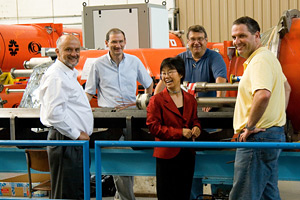 |
Fermilab Director Pier Oddone, CERN physicist Ranko Ostojic, Fermilab Deputy Director Young-Kee Kim, Fermilab physicist Peter Limon and Fermilab engineer Jim Kerby on a visit to a magnet assembly building at CERN in May 2007.
Credit: Tom Nicol, Fermilab |
September 28, 2007 — LHC triplet repairs complete
A team from CERN, Fermilab, Japan’s KEK Laboratory and Lawrence Berkeley National Laboratory have successfully completed repairs to all triplet assemblies at CERN’s Large Hadron Collider. The triplet components are now in the LHC tunnel for installation and testing. So far, three of eight triplets have been installed and successfully pressure tested in the tunnel. The remaining triplets are in the process of installation and pressure testing, to be followed by cooldown and powering in accordance with CERN’s LHC schedule.
The triplets, which include three superconducting quadrupole magnets and the associated cryogenic and power distribution boxes, or DFBXs, will focus particle beams prior to collisions at each of four interaction regions in the LHC when it begins operating in 2008.
The repairs addressed problems with superconducting magnet assemblies furnished by Fermilab. Internal support structures broke in one triplet during a pressure test on March 27. To effect the repair, teams attached sets of four metal cartridges to each magnet assembly to limit movement of the magnets inside their metal jackets or cryostats. The teams also fixed design problems in the DFBXs and in the attachments of magnets to the tunnel floor.
Read more...
|
|
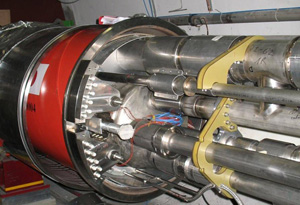 |
| A Q1 magnet assembly with cartridges held in place by the four earlike brackets bolted to the outer flange.
|
July 20, 2007 — Inner Triplet Successfully Completes Pressure Test
An inner triplet assembly of quadrupole magnets at Point 8-Right of the LHC at CERN successfully completed a pressure test in the accelerator tunnel on Friday, July 13. The triplet, which included three quadrupole magnets and the associated cryogenic and power distribution box, or DFBX, met all test specifications at the requisite pressure of 25 atmospheres for one hour. The triplets will focus particle beams prior to particle collisions at each of four interaction regions in the Large Hadron Collider, now under construction at CERN.
The pressure test is designed to test the accelerator components in conditions that will occur during LHC operations. To withstand the asymmetrical forces generated by the pressure, the Q1 and Q3 magnets, at either end of the triplet assembly had each been fitted with a set of four metal cartridges. The cartridges reinforce internal support structures that broke in two such magnets during an earlier pressure test on March 27. The cartridges limit movement of the magnets inside their metal jackets, or cryostats.
Metal brackets attach the cartridges to one end of each of the affected magnets. The cartridges have a compound design consisting of an aluminum alloy tube and an Invar rod to allow them to function over a broad range of temperatures. Invar is a form of steel whose dimensions change very little in response to temperature differences.
Read more...
|
|
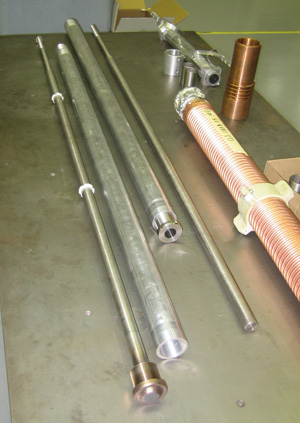 |
| Pieces for the assembly of cartridges for triplet repair have begun to arrive at CERN, including aluminum outer tubes and Invar rods that fit into the tubes. At right is one of the new heat exchangers installed in the triplet magnets. (Image courtesy of Peter Limon.)
|
June 1, 2007 — LHC Triplet Repairs Underway at CERN
Scientists, engineers and technicians from CERN, Fermilab, Lawrence Berkeley National Laboratory and Japan's KEK laboratory have begun repairs to the "triplet" components of the Large Hadron Collider that failed a pressure test in the LHC tunnel in March.
Following a mechanical review at CERN of the triplets and the proposed fixes on April 24 and 25, Fermilab also conducted a review of the magnet fixes on May 16-17, and of the repairs to the cryogenic and power distribution boxes, or DFBXs, on May 24. All reviews concurred with the design choices for triplet repairs and recommended areas for further investigation and testing to forestall any potential problems.
As described in the May 11 Update, a set of four metal cartridges will be installed in each of 18 quadrupole magnet assemblies to reinforce the internal support structures that broke in one such magnet during the pressure test.
Materials for the cartridges have arrived at CERN, where tests of individual cartridge components and joints are underway. Following assembly and testing of the cartridges, they will be installed in a triplet quadrupole magnet currently in a surface building at the laboratory. Engineers will use a hydraulic device to simulate the asymmetric forces applied to the magnet during a pressure test. After the hydraulic test has shown that the cartridges in fact keep the magnet from moving, as they are designed to do, cartridges will be installed in the remaining triplet magnets. Most of the installation work will be done without removing the magnets from the LHC tunnel.
The March pressure test also revealed minor design problems in the triplets' DFBX's, for which fixes have been designed, reviewed, and agreed on. Parts are being made and tested, and plans call for repairs to begin in mid-June.
Read more...
|
|
 |
| The Q1 magnet (blue) with cartridges (red) attached. |
May 11, 2007 — Preparations for Magnet Repairs Proceed
Scientists and engineers from CERN, Fermilab, Lawrence Berkeley National Laboratory and Japan's KEK Laboratory are preparing for repairs of 18 sets of structural supports to Fermilab-built quadrupole magnets for the LHC accelerator under construction at CERN. On Tuesday, March 27, the structural supports to one quadrupole magnet, part of an "inner triplet" of three magnets named Q1, Q2, Q3, failed a high-pressure test in the LHC tunnel. Fermilab assembled nine inner triplets for the LHC, including one spare. They are used to focus the proton beams of the particle collider before they enter the four interaction points along the ring.
To fix the structural supports' design flaw, the team of scientists and engineers has proposed to add to each Q1 magnet and each Q3 magnet a set of four cartridges that can absorb the longitudinal force generated during the pressure test. The solution was presented to a team of experts during a review at CERN on April 24 and 25. Since then the design of the cartridge system has been refined and parts needed for the cartridges and their installation have been ordered. Detailed tests of the design are in progress. The final design reviews will take place at Fermilab and CERN over the next couple of weeks.
Read more...
|
|
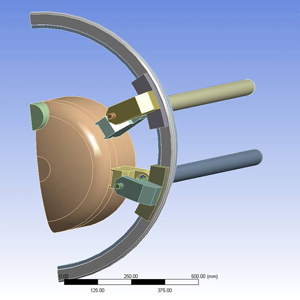 |
| To strengthen the support structure of the magnets in the "inner
triplet," cartridges will be attached to one of the ends of the Q1 magnet and to one of the ends of the Q3 magnet. |
April 27, 2007 — Fermilab Update on LHC Inner Triplets
A team of experts from CERN, from CEA-Saclay (a French national laboratory), and from Brookhaven National Laboratory met at CERN on April 24 and 25 to review proposed solutions to the problems that caused the failure of a Fermilab-built "inner triplet" of superconducting magnets during a routine pressure test on March 27. Physicists and engineers from Fermilab and Lawrence Berkeley National Laboratory participated in the review
Each triplet contains three superconducting magnet assemblies, a cryogenic and power distribution box for the magnets, and associated structures. The triplets will focus particle beams prior to particle collisions in the Large Hadron Collider, now under construction at CERN. The pressure test took place in the accelerator tunnel.
The CERN review team examined the mechanical design of the inner triplet to make sure that there are no further hidden defects and conducted a review of the proposed in-situ repairs.
Read more...
|
|
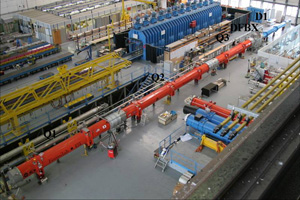 |
| The components of the inner triplet, as they appeared when assembled for the first time in a surface building at CERN, in April 2005. The assembly contains, from left to right, three quadrupole magnets (Q1, Q2, Q3), a cryogenic and power distribution box (DFBX), and a separation dipole magnet
(D1). |
April 20, 2007 — Redesign and repair
Since March, teams at CERN and Fermilab have worked closely together to identify the cause of the failure and to identify any other potential problems with U.S.-furnished components. The teams have identified several potential solutions.
The teams have also identified damage caused by the same pressure test to the cryogenic and power distribution box, or DFBX, the structure that feeds power and cryogenic fluids to the inner triplet magnets. Minor repairs will be needed to the DFBXs, which were supplied by Lawrence Berkeley National Laboratory. LBNL scientists and engineers have joined the CERN-Fermilab team carrying out the design and implementation of these repairs.
Read more...
|
|
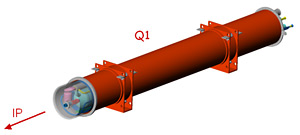 |
| Q1 Quadrupole Magnet – CERN and Fermilab are working to identify repairs to the structures that hold the cold mass (blue) in place within the cryostat (orange) in each magnet of the triplet on either side of the LHC's four interaction points. The Q1 magnet of each triplet is the magnet closest to the interaction point (IP). |
April 3, 2007 — Fermilab Update on Inner Triplet Magnets at LHC
The asymmetric force generated by the pressure of the test broke the supports in magnet Q1 that hold the magnet’s cold mass inside the cryostat, which also resulted in damage to the electrical connections. The status of the Q1 cold mass itself is still being determined, as is the status of the other two magnets in the triplet, Q2 and Q3. Also under investigation is the status of a distribution feed box, or DFBX, designed to provide cryogenic fluids and electrical power for the inner triplet magnets.
Read more...
|
|
 |
| Pier Oddone |
April 3, 2007 — Director's Corner: The World Stage
Last Tuesday we took a pratfall on the world stage: the high pressure test of the Fermilab-built inner triplet failed dramatically in the LHC tunnel with a loud "bang" and a cloud of dust. It was the first time that the three magnets together with the associated interface box (DFBX) that supplies them with the cryogenic and electrical connections had been tested as an assembly. The high pressure test simulated conditions that can occur in a quench of an LHC sector. Teams at CERN and Fermilab have quickly determined the reason for the failure and are in the process of designing a solution to the problem.
Read more...
|
|
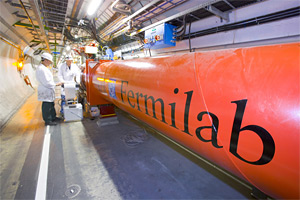 |
| An inner-triplet quadrupole during installation in June 2006. |
March 29, 2007 — Fermilab Statement on LHC Magnet Test Failure
On Tuesday, March 27, there was a serious failure in a high-pressure test at CERN of a Fermilab-built “inner-triplet” series of three quadrupole magnets in the tunnel of the Large Hadron Collider. The magnets focus the particle beams prior to collision at each of four interaction points around the accelerator.
Safety precautions were followed during the test, and no one was injured.
Read more...
|
|
|